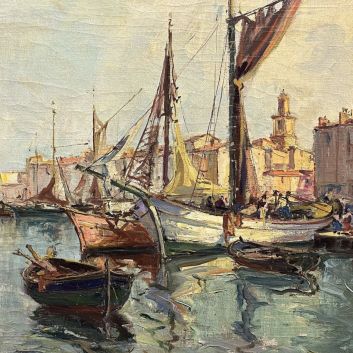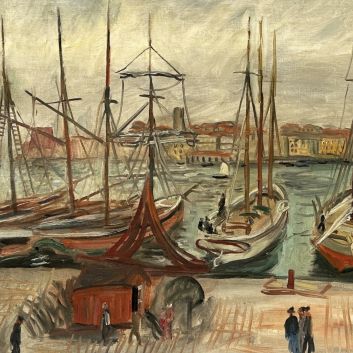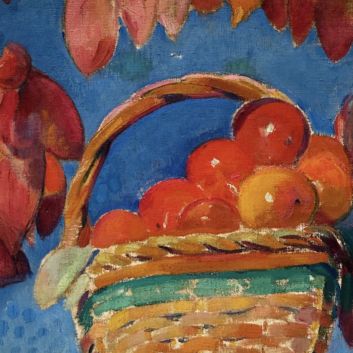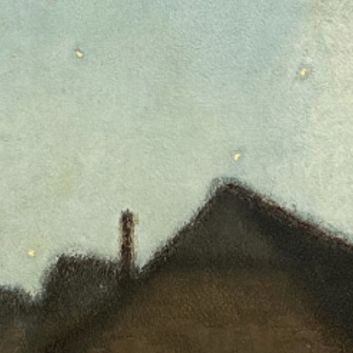Rating and value of paintings by Paul Élie Ranson

If you own a work by or based on the artist Paul Élie Ranson and would like to know its value, our state-approved experts and auctioneers can help you.
Our specialists will carry out a free appraisal of your work, and provide you with a precise estimate of its current market value.
Then, if you want to sell your work, we'll point you in the right direction to get the best possible price for it.
Artist's rating and value
A Nabi painter, Paul Élie Ranson enjoys a fairly high standing on the art market today - especially when it comes to his paintings.
Appreciated by collectors, some of his paintings can sell for hundreds of thousands of euros at auction: the price at which they sell on the art market ranges from €30 to €400,000, a considerable delta but one that speaks volumes about the value that can be attributed to the artist's works.
In 2020, his oil on canvas Trois baigneuses aux Iris ou Femmes au bain, dating from 1896, sold for €400,000, whereas it was estimated at €250,000 to €350,000.
Order of value from the most basic to the most prestigious
Technique used | Results |
|---|---|
Print - multiple | From €30 to €20,000 |
Drawing - watercolor | From €60 to €175,000 |
Paint | From €700 to €400,000 |
Response in less than 24h
Artist's style and technique
Paul Élie Ranson (1861-1909) was a Nabi and Symbolist artist.
He was one of the founding members of the Nabis group. He developed a synthetic, decorative and spiritual pictorial language, breaking with naturalism.
In terms of Symbolist affinities, his work was distinguished from other Nabis by a marked mystical and esoteric vein, close to the art of Redon or Gustave Moreau.
The artist was fascinated by theosophy, esotericism, magic and symbolic theater, and so often incorporated religious or pagan elements into his compositions.
Ranson often worked with decorative compositions, using circled shapes, flat areas of bright color, and working on the illusionistic absence of depth. His work is influenced by Japanese prints and Gauguin's Cloisonnism.
His drawings are mostly stylized and synthetic, favoring simplified, sometimes almost childlike forms in favor of the overall harmony of the image. His palette is warm and unearthly, and the colors he uses are rich and contrasting (deep reds, golds, purplish blues), creating a dreamlike or ritualistic atmosphere.
He also uses matte, opaque textures, applying paint evenly, without academic modeling, with sharp, sometimes decorative contours. The mixed media he uses in addition to oil paint enrich his body of work (decorative panels, illustrations, puppets and theater sets).
He works with recurring themes, depicting allegories and mythical figures such as witches, priestesses, satyrs, Sabbath scenes or invocations - all of which come from the direct influence of his interest in the occult sciences.
Magical or fatal women are present in many of her works, often nude or draped, embodying mysterious and ambivalent forces. The artist also uses vegetal symbolism, with sinuous lines, imaginary plants and stylized decorations reinforcing the link between nature and spirituality.
Paul-Élie Ranson's work thus bridges the gap between Art Nouveau and Symbolism, insofar as Ranson's taste for decoration and mystery prefigured Art Nouveau while extending the Symbolist imagination.
He is a singular voice among the Nabis, as his work is less concerned with everyday life than Vuillard or Bonnard, and more concerned with exploring the margins of consciousness and the sacred.


Paul Élie Ranson, his life and work
Paul Élie Ranson (1861 - 1909) was born in Limoges. The son of a drawing school director, he was introduced to the plastic arts at an early age. He trained at the École des Beaux-Arts de Limoges, then at the Beaux-Arts de Paris. He then chose the Académie Julian, where he met Sérusier, Bonnard, Denis and Vuillard, a group of artists who were to form the future nucleus of the Nabi group.
He co-founded the Nabis group in 1888, alongside Paul Sérusier, with the aim of breaking away from academicism and turning painting into a spiritual language. He took an active part in the Nabis exhibition, notably at the Salon des Indépendants and with the dealer Le Barc de Boutteville.
He produced a number of decorative works, including screens, wall panels, illustrations, theater sets and puppets, in a synthetic, symbolist spirit.
In 1891, he founded the Théâtre d'Art et de marionnettes, where he designed the sets and texts, blending mysticism and visual art.
Weakened by a chronic illness (probably tuberculosis or an intestinal ailment), he endured difficult years punctuated by frail health towards the end of his life. He died prematurely in Paris at the age of 47.
Although he is less well known today than Bonnard or Vuillard, he was rediscovered in the 20th century as a singular representative of Nabi symbolism, at the crossroads of esotericism, Art Nouveau and decorative painting.

Focus on Witches around the fire, Paul Élie Ranson, 1891
The work depicts an occult and ritualistic scene, a circle of naked witches crouching around a fire in a stylized nocturnal passageway. The composition is constructed in rotation, with the bodies forming a ring around the central flame, reinforcing the effect of magical ritual.
There's an absence of precise narrative: it's not a story but a suspended scene, like a dream or a symbolic vision. The painting's atmosphere is designed to be strange and bewitching: the bodies are pale, the attitudes frozen, the dark background and the flames suggest a scene between magic, sleep and hypnosis.
The circle, fire and ritual nudity allude to the occult practices and theosophical beliefs dear to Ranson's heart. He also alludes to the witch as a figure of feminine power: far from caricature, women here are almost sacred, like priestesses of ancient knowledge.
Shapes are outlined and worked with flat tints of color. Bodies are stylized, with clean contours, and colors are applied in broad, matte areas without modeling, in the Nabi spirit.
The palette used by the artist is dark and contrasting, with ochres, reds and deep blacks dominating, accentuating the nocturnal and sacred character of the scene.
This is a deliberate simplification, since Ranson was looking for an image-symbol rather than a realistic scene, in the manner of the Japanese prints he admired.
The work thus blends archaism (witchcraft, fire) and avant-garde (stylization, schematization), to propose a painting that speaks to the unconscious.
This vision of feminine magic and the initiatory circle can also be read as a projection of Ranson's own spiritual universe.
His signature
Not all Paul Élie Ranson's works are signed.
Although there are variations, here's a first example of his signature.
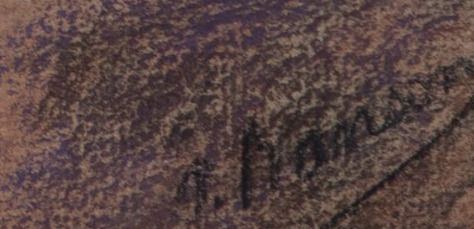
Appraising your property
If you happen to own one of Paul Élie Ranson's works, ask for a free estimate without delay, using the form on our website.
A member of our team of experts and certified auctioneers will contact you promptly to provide you with an estimate of the value of your work, as well as any relevant information about it.
If you're thinking of selling your work of art, our specialists will also be on hand to help you find alternative ways of selling it at the best possible price.
Response in less than 24h
Related topics
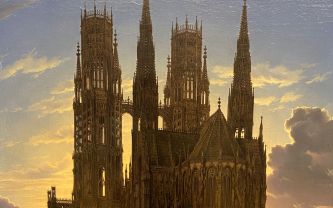
Rating and value of works, paintings by Friedrich Overbeck
Friedrich Overbeck was a German neoclassical painter who lived in Rome. His religious paintings are highly prized at auction.
Read more >
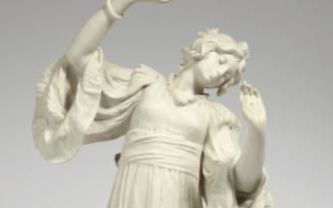
Agathon Léo's porcelain cookie quotation and value 2024...
Agathon Léonard was an Art Nouveau sculptor who created porcelain cookies for the Manufacture de Sèvres, which are listed at auction.
Read more >

Rating and value 2024 of paintings by Marius Borgea...
Marius Borgeaud is a 19th-century luminist painter who produced paintings that are increasingly popular and valuable at auction.
Read more >
Secure site, anonymity preserved
State-approved auctioneer and expert
Free, certified estimates

